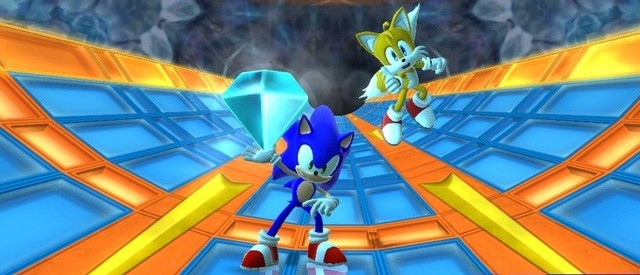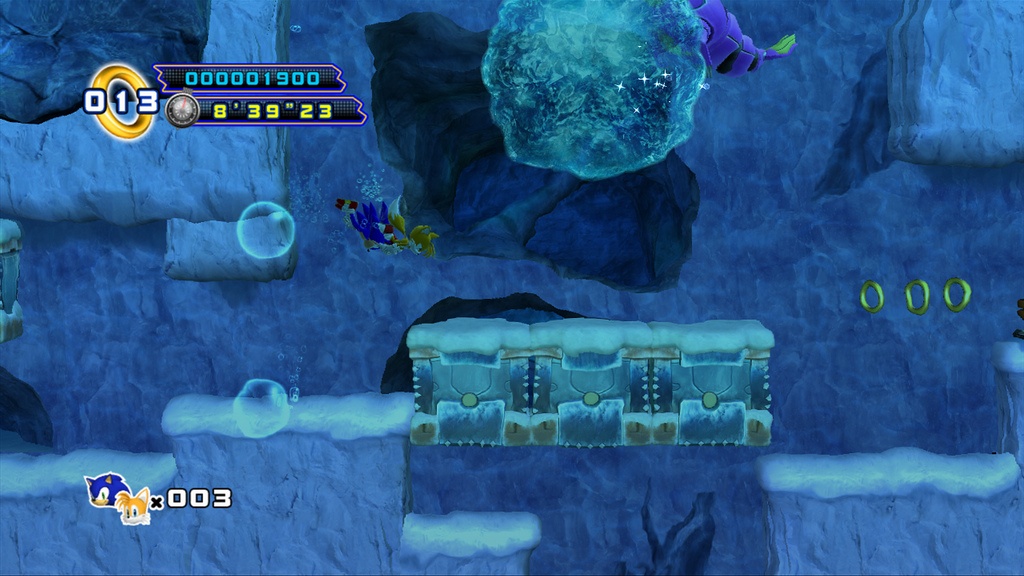

Many gamers consider Sonic the Hedgehog 2 to be the high point in the series. With fantastic graphics, terrific level design, and unparalleled soundtrack, cool bonus levels, and even 2-player co-op and versus modes, Sonic 2 had everything you could’ve wanted in a platforming sequel. It also sold heaps of Sega Genesis consoles, because nothing on the Super Nintendo could really match it at the time. Sonic the Hedgehog 4: Episode II, the newest downloadable Sonic title, wisely draws its inspiration from Sonic 2, attempting to update that classic for the modern era. Though it doesn’t quite recapture all of the Genesis-era magic (a nearly impossible task), Episode II successfully improves on many of the first Sonic 4’s faults while adding the best co-op play the series has ever seen.
A quick recap of Episode I: the game spanned four zones with three acts a piece, plus five bosses. Zones and bosses were all based on those of the Genesis games. Story sequences, which have been a big part of the series since 1999’s Sonic Adventure, were completely absent. This back-to-basics approach didn’t quite ring true with many Genesis fans for a few reasons: awkward movement physics for Sonic, largely mediocre level design, and lackluster chiptunes music courtesy of Sonic & Knuckles composer Jun Senoue. I still enjoyed it as a platformer regardless, but not everyone felt the same way.
Before we talk about Episode II’s new additions, let’s see how it stacks up against those old complaints. Sonic’s movement physics are now much closer to the original games, restoring the sense of weight and momentum we all missed in the last installment. The bosses are much larger, more original, and fun to fight this time around. Surprisingly, the final boss is now a complete pushover, a welcome relief after the tough Metal Sonic race preceding him (or the annoying last battle of Episode I). Also, the graphics have improved significantly, with new light and shadow effects and plenty of parallax providing the requisite eye candy. The music remains as repetitive and uninspired as Episode I, sadly.

Just one more reason to hate walruses.
Cutting into the fun factor a bit, the level design hasn’t improved in any significant way. Oh, they’re all gorgeous. But frustrating trial and error bits still pop up now and then – the worst of which occurs in White Park Act 3. Not only is it an underwater level (of which there are at least four in this installment, yikes), but the new walrus enemies seem designed specifically to infuriate. They produce giant blocks of ice if you don’t kill or pass them by quickly enough. Problem: Sonic can’t break the ice they form; the baddies are just invincible at that point. One spot with two walruses completely blocking the path is guaranteed to kill players the first time through. I just can’t see why Dimps would make those enemies indestructible as it really hampers the flow of the level.
Don’t think the new levels are all bad though – Oil Desert and Sky Fortress are especially enjoyable. The former involves activities like sliding down oil slicks, staying out of quick sand, and frantically climbing a silo as it fills with the suffocating grains. Sky Fortress starts out with Sonic riding along on Tails’ biplane, just like the good old days. In single-player, one person controls the movement of the plane as well as Sonic’s jumps. Co-op splits the control duties, with the Tails player steering and the Sonic player able to jump or walk along the plane independently while still remaining tethered to it.
Speaking of new levels, the rotation-maze special stages from Episode I have been replaced by Sonic 2-style half-pipes. These provide a nostalgic blast and also introduce some cool new mechanics like an item that strings a ring-collecting tether between Sonic and Tails. They also get pretty tough, but thankfully you can pause and select to retry any special stage or even the regular ones without losing a life. I only wish the proper bonus stage music from Sonic 2 or the Saturn version of Sonic 3D Blast had been used instead of the included wannabe track. At least the reward for collecting every Chaos Emerald, Super Sonic, can be used during boss battles now in addition to regular stages.
Now to discuss this episode’s best new feature: the return of Tails the fox. Whether played solo or co-op, Tails accompanies Sonic for the entire journey. For the most part he just follows along in single-player, not doing much he’s not told to do. Still, the new combo moves turn the little guy from third wheel to indispensable partner pretty quickly. As you complete the first three acts, Tails gains the ability to carry Sonic in the air or water and perform a rolling attack with him. The levels are designed with these moves in mind, and floating signs often indicate opportune moments to use them.
As you can imagine, the combo moves really enhance the cooperative element during 2-player games. First, you’ll need to assign who plays as whom. Sonic and Tails really lean on each other since each character performs a specific role. When Tails carries Sonic, the Tails player controls the flight or swimming. Sonic and choose to jump off and homing attack enemies though – an important tactic during boss battles. Initiating these moves could have been a hassle had they required specific positioning of either player. Thankfully, pressing the combo move button (X on Xbox 360) instantly warps Tails to Sonic’s position and starts the appropriate move, depending on whether initiated from land, sea, or air.
Combo moves aren’t the only things that make Tails more entertaining to play in co-op this time out. Previously, if Tails fell off-screen, it took several seconds for him to reappear and become controllable again. Now, if either character falls behind, he turns into a ball and floats behind the lead character. You can float along like that if you’re having trouble with a particular segment, or press a button at any time to jump back into control. Note that both players share the same pools of rings and lives, so a bad player can botch things for the other person. Assuming you have lives remaining when one person dies, he or she can always respawn alongside the living player. Should both players die at once, it’s back to the last checkpoint.
A few more co-op particulars: Both local and online co-op are separate modes, so a second player can’t just drop into a single-player game. On the other hand, both players get to save their own progress and earn Achievements, so I’m not complaining. Speaking of which, you can only select from levels that both players have unlocked in local co-op games, so if one player is far behind, the other will need to help them catch up before moving on. One slight co-op quirk: the new in-game cinematics don’t show up in multiplayer. Players who go through the game in co-op first will need to revisit it in single-player to catch those bits.
It’s always great when a developer takes fan feedback into account. Sonic the Hedgehog 4: Episode II improves on its predecessor in a number of ways, even if the levels and music could still use some work. The additional bonus of Episode Metal (four single-player remixed acts played from Metal Sonic’s perspective) for Episode I owners also shows that somebody at SEGA values their loyal fans. Most importantly for co-op enthusiasts, Episode II was designed from the ground up as a co-op title and it shows. Tearing through stages and thwarting Metal Sonic and Eggman with a friend feels so good, you’ll wonder why every Sonic game hasn’t included a team-up option. Certain segments of Sonic fandom are impossible to please and will inevitably turn their noses up at this entry like they do all the others. But if you're sane and appreciate a good co-op platformer, Episode II is a must-have.
Editor's Note: The Co-Optimus Co-Op Review of Sonic 4 Episode II was based on the Xbox 360 version of the game. The review copy was provided by the publisher.